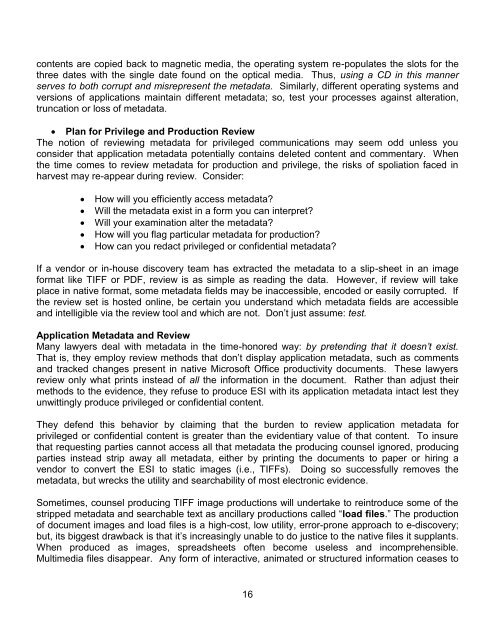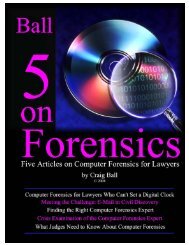Litigator's Guide to Metadata - Codemantra.net
Litigator's Guide to Metadata - Codemantra.net
Litigator's Guide to Metadata - Codemantra.net
- No tags were found...
Create successful ePaper yourself
Turn your PDF publications into a flip-book with our unique Google optimized e-Paper software.
contents are copied back <strong>to</strong> mag<strong>net</strong>ic media, the operating system re-populates the slots for thethree dates with the single date found on the optical media. Thus, using a CD in this mannerserves <strong>to</strong> both corrupt and misrepresent the metadata. Similarly, different operating systems andversions of applications maintain different metadata; so, test your processes against alteration,truncation or loss of metadata. Plan for Privilege and Production ReviewThe notion of reviewing metadata for privileged communications may seem odd unless youconsider that application metadata potentially contains deleted content and commentary. Whenthe time comes <strong>to</strong> review metadata for production and privilege, the risks of spoliation faced inharvest may re-appear during review. Consider:How will you efficiently access metadata?Will the metadata exist in a form you can interpret?Will your examination alter the metadata?How will you flag particular metadata for production?How can you redact privileged or confidential metadata?If a vendor or in-house discovery team has extracted the metadata <strong>to</strong> a slip-sheet in an imageformat like TIFF or PDF, review is as simple as reading the data. However, if review will takeplace in native format, some metadata fields may be inaccessible, encoded or easily corrupted. Ifthe review set is hosted online, be certain you understand which metadata fields are accessibleand intelligible via the review <strong>to</strong>ol and which are not. Don’t just assume: test.Application <strong>Metadata</strong> and ReviewMany lawyers deal with metadata in the time-honored way: by pretending that it doesn’t exist.That is, they employ review methods that don’t display application metadata, such as commentsand tracked changes present in native Microsoft Office productivity documents. These lawyersreview only what prints instead of all the information in the document. Rather than adjust theirmethods <strong>to</strong> the evidence, they refuse <strong>to</strong> produce ESI with its application metadata intact lest theyunwittingly produce privileged or confidential content.They defend this behavior by claiming that the burden <strong>to</strong> review application metadata forprivileged or confidential content is greater than the evidentiary value of that content. To insurethat requesting parties cannot access all that metadata the producing counsel ignored, producingparties instead strip away all metadata, either by printing the documents <strong>to</strong> paper or hiring avendor <strong>to</strong> convert the ESI <strong>to</strong> static images (i.e., TIFFs). Doing so successfully removes themetadata, but wrecks the utility and searchability of most electronic evidence.Sometimes, counsel producing TIFF image productions will undertake <strong>to</strong> reintroduce some of thestripped metadata and searchable text as ancillary productions called ―load files.‖ The productionof document images and load files is a high-cost, low utility, error-prone approach <strong>to</strong> e-discovery;but, its biggest drawback is that it’s increasingly unable <strong>to</strong> do justice <strong>to</strong> the native files it supplants.When produced as images, spreadsheets often become useless and incomprehensible.Multimedia files disappear. Any form of interactive, animated or structured information ceases <strong>to</strong>16













